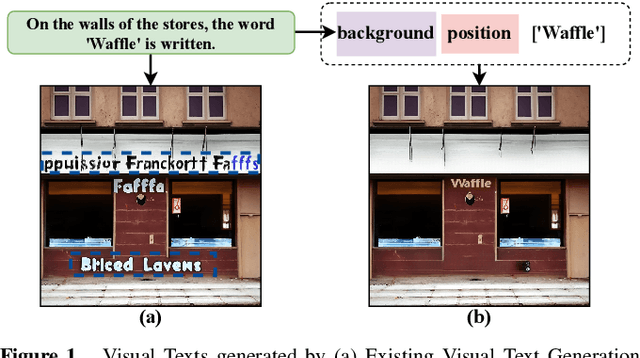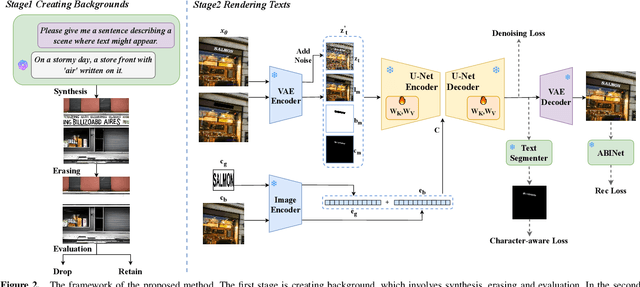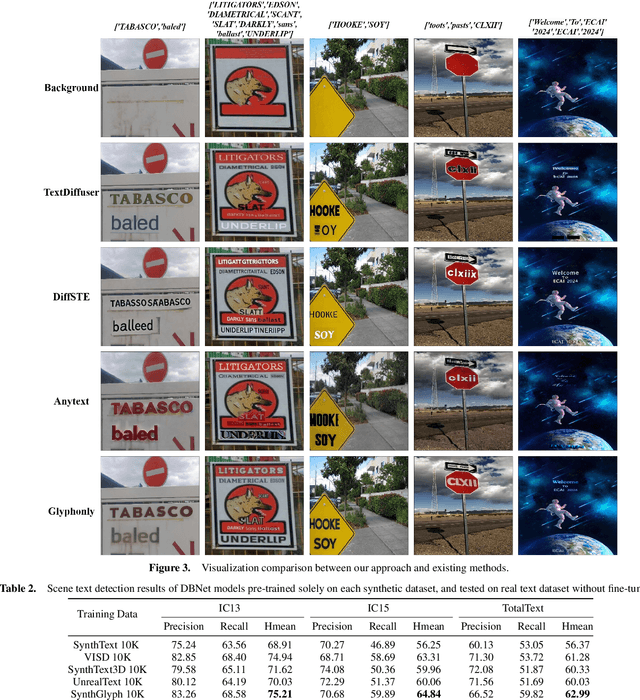Weichao Zeng
Beyond Flat Text: Dual Self-inherited Guidance for Visual Text Generation
Jan 10, 2025Abstract:In real-world images, slanted or curved texts, especially those on cans, banners, or badges, appear as frequently, if not more so, than flat texts due to artistic design or layout constraints. While high-quality visual text generation has become available with the advanced generative capabilities of diffusion models, these models often produce distorted text and inharmonious text background when given slanted or curved text layouts due to training data limitation. In this paper, we introduce a new training-free framework, STGen, which accurately generates visual texts in challenging scenarios (\eg, slanted or curved text layouts) while harmonizing them with the text background. Our framework decomposes the visual text generation process into two branches: (i) \textbf{Semantic Rectification Branch}, which leverages the ability in generating flat but accurate visual texts of the model to guide the generation of challenging scenarios. The generated latent of flat text is abundant in accurate semantic information related both to the text itself and its background. By incorporating this, we rectify the semantic information of the texts and harmonize the integration of the text with its background in complex layouts. (ii) \textbf{Structure Injection Branch}, which reinforces the visual text structure during inference. We incorporate the latent information of the glyph image, rich in glyph structure, as a new condition to further strengthen the text structure. To enhance image harmony, we also apply an effective combination method to merge the priors, providing a solid foundation for generation. Extensive experiments across a variety of visual text layouts demonstrate that our framework achieves superior accuracy and outstanding quality.
First Creating Backgrounds Then Rendering Texts: A New Paradigm for Visual Text Blending
Oct 14, 2024



Abstract:Diffusion models, known for their impressive image generation abilities, have played a pivotal role in the rise of visual text generation. Nevertheless, existing visual text generation methods often focus on generating entire images with text prompts, leading to imprecise control and limited practicality. A more promising direction is visual text blending, which focuses on seamlessly merging texts onto text-free backgrounds. However, existing visual text blending methods often struggle to generate high-fidelity and diverse images due to a shortage of backgrounds for synthesis and limited generalization capabilities. To overcome these challenges, we propose a new visual text blending paradigm including both creating backgrounds and rendering texts. Specifically, a background generator is developed to produce high-fidelity and text-free natural images. Moreover, a text renderer named GlyphOnly is designed for achieving visually plausible text-background integration. GlyphOnly, built on a Stable Diffusion framework, utilizes glyphs and backgrounds as conditions for accurate rendering and consistency control, as well as equipped with an adaptive text block exploration strategy for small-scale text rendering. We also explore several downstream applications based on our method, including scene text dataset synthesis for boosting scene text detectors, as well as text image customization and editing. Code and model will be available at \url{https://github.com/Zhenhang-Li/GlyphOnly}.
TextCtrl: Diffusion-based Scene Text Editing with Prior Guidance Control
Oct 14, 2024



Abstract:Centred on content modification and style preservation, Scene Text Editing (STE) remains a challenging task despite considerable progress in text-to-image synthesis and text-driven image manipulation recently. GAN-based STE methods generally encounter a common issue of model generalization, while Diffusion-based STE methods suffer from undesired style deviations. To address these problems, we propose TextCtrl, a diffusion-based method that edits text with prior guidance control. Our method consists of two key components: (i) By constructing fine-grained text style disentanglement and robust text glyph structure representation, TextCtrl explicitly incorporates Style-Structure guidance into model design and network training, significantly improving text style consistency and rendering accuracy. (ii) To further leverage the style prior, a Glyph-adaptive Mutual Self-attention mechanism is proposed which deconstructs the implicit fine-grained features of the source image to enhance style consistency and vision quality during inference. Furthermore, to fill the vacancy of the real-world STE evaluation benchmark, we create the first real-world image-pair dataset termed ScenePair for fair comparisons. Experiments demonstrate the effectiveness of TextCtrl compared with previous methods concerning both style fidelity and text accuracy.
PianoBART: Symbolic Piano Music Generation and Understanding with Large-Scale Pre-Training
Jun 26, 2024



Abstract:Learning musical structures and composition patterns is necessary for both music generation and understanding, but current methods do not make uniform use of learned features to generate and comprehend music simultaneously. In this paper, we propose PianoBART, a pre-trained model that uses BART for both symbolic piano music generation and understanding. We devise a multi-level object selection strategy for different pre-training tasks of PianoBART, which can prevent information leakage or loss and enhance learning ability. The musical semantics captured in pre-training are fine-tuned for music generation and understanding tasks. Experiments demonstrate that PianoBART efficiently learns musical patterns and achieves outstanding performance in generating high-quality coherent pieces and comprehending music. Our code and supplementary material are available at https://github.com/RS2002/PianoBart.
Visual Text Meets Low-level Vision: A Comprehensive Survey on Visual Text Processing
Feb 05, 2024Abstract:Visual text, a pivotal element in both document and scene images, speaks volumes and attracts significant attention in the computer vision domain. Beyond visual text detection and recognition, the field of visual text processing has experienced a surge in research, driven by the advent of fundamental generative models. However, challenges persist due to the unique properties and features that distinguish text from general objects. Effectively leveraging these unique textual characteristics is crucial in visual text processing, as observed in our study. In this survey, we present a comprehensive, multi-perspective analysis of recent advancements in this field. Initially, we introduce a hierarchical taxonomy encompassing areas ranging from text image enhancement and restoration to text image manipulation, followed by different learning paradigms. Subsequently, we conduct an in-depth discussion of how specific textual features such as structure, stroke, semantics, style, and spatial context are seamlessly integrated into various tasks. Furthermore, we explore available public datasets and benchmark the reviewed methods on several widely-used datasets. Finally, we identify principal challenges and potential avenues for future research. Our aim is to establish this survey as a fundamental resource, fostering continued exploration and innovation in the dynamic area of visual text processing.
 Add to Chrome
Add to Chrome Add to Firefox
Add to Firefox Add to Edge
Add to Edge